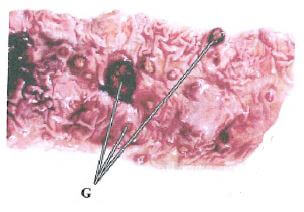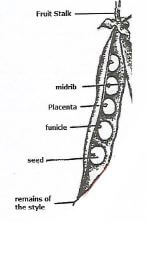QUESTIONS
- The photographs below represent three mammalian bones, labelled E, F and G.

- With reasons, identify the bones.
Bone Identity Reason(s)
E ...................... ..............................
F ...................... ..............................
G ...................... .............................. - Name the joints formed at the anterior and posterior ends of F.
Anterior end .................
Posterior end................. - State the types of movement facilitated by the joint at the anterior end of specimen labelled F.(1 mark)
-
- Name the substance found inside the living tissue of the specimen represented in photograph F.(1 mark)
- State the function of the substance named in (d) (i) above. (1 mark)
-
- Name the muscle bundle usually attached onto the front of the specimen represented in photograph F. (1 mark)
- State the function of the muscle bundle name: in (e) (i) above. (1 mark)
- With reasons, identify the bones.
- Below is a photograph of a blood smear from a normal individual. The arrangement is arbitrary and the number of blood elements is greater than what would normally occur in an actual microscopic field.

-
- Name the blood elements labelled J, K and L.(3 marks)
J......................................
K......................................
L...................................... - State one function of each of the elements named in (a) (i) above.(3 marks)
J......................................
K......................................
L......................................
- Name the blood elements labelled J, K and L.(3 marks)
- The photograph below is of a section of the human intestines of a patient suffering from a common parasitic disease.

- Name the disease.(1 mark)
- Name the parasite that causes the disease in (b)) above.(1 mark)
- State two control measures for the disease.(2 marks)
- State the effects of having the parts labelled in the patient's intestines.(2 marks)
-
- You are provided with a specimen labelled H. With the aid of a hand lens, examine the external features of the specimen.
-
- What part of a plant is specimen H?(1 mark)
- Give two reasons for your answer in (a) C above.(2 marks)
- Open up specimen H longitudinally,
Use a hand lens to observe the internal structures of specimen H.- Draw and label the internal cut surface and associated structures of specimen H.(5 marks)
- Explain how you would determine the magnification of the drawing made in (b) (i) above.(2 marks)
- State the mode of dispersal for seeds of specimen H.(1 mark)
- Explain how seeds of specimen H are dispersed through the mode stated in (b)(iii) above.(3 marks)
-
MARKING SCHEME
-
- E scapula/shoulder blade;
- Has a socket/glenoid cavity/depression to articulate with the ball/head of the humerus;
- Flat/triangular-shaped flat blade/triangular shaped flat blade/flattened::
- Has a spine/ridge/coracoids process/acromion for attachment of muscles;
F-Humerus; - Has a ball/head/rounded head that articulates with the glenoid cavity/ socket on the scapula;
- Has condyles that articulate with radius and ulna;
G-Radius attached to ulna; . - Ulna has a sigmoid notch for articulation with the shoulder joint/ lower end of the humerus
- Has trochlea/olecranon fossa;
- Has greater/larger tuberosity
- Has biciptal groove;
-
- Ball and socket (joint);
- Hinge joint;
- Rotation/up and down/side-ways (of the arm);
-
- Bone marrow;
- Manufacture of (red) blood cells;
-
- Biceps;
- Contract relax to move the lower arm (upwards);
- E scapula/shoulder blade;
-
-
- J- Erythrocyte(3)/red blood cell;
K-Leucocyte/white blood cell;
L-Thrombocytes/Platelets - J - Transportation of oxygen/carbon (IV) oxide;
K-Engulf/attack pathogens/ foreign materials in the blood;
L--Blood clotting
- J- Erythrocyte(3)/red blood cell;
-
- Amoebic dysentery:
- Entamoeba hystolytica;
- -Boiling drinking water (before drinking);/
-Chlorinating/treating drinking water,
-Keeping the food covered to keep away flies/prevent contamination/proper storage of food;
-Proper faecal disposal in pit latrines/toilets/keeping the same clear/not to dispose faecal materials in the open/washing hands before handling food/ washing fruits/food before eating after visiting toilet/latrine,
-Proper cooking of food;
-Washing hands before handling of food/washing fruits before eating: - -Pain (especially during feeding)
-Bloody stool;
-Impaired absorption (of digested food materials):
-
-
-
- Fruit(s);
- Has two scars; point of attachment to remains of style, and point of attachment to the receptacle fruit stalk
- Presence of seeds,
- Presence of pericarp/fruit wall
- Has epicarp, mesocarp and endocarp fused;
-

- -Correct, complete diagram with continuous outline-2 marks
-Any three correctly labelled parts-3 marks. - Linear magnification = Length of drawing:
Actual length of object (specimen); OWTTE - Explosive mechanism/self-dispersal mechanism/self explossive;
- Dry pods, due to loss of water from the pod and pressure from within the pod; the pod opens (violently) along the sutures /lines of weakness; seeds are thrown away from the parent plant/dispersed;
- -Correct, complete diagram with continuous outline-2 marks
-
Join our whatsapp group for latest updates
Tap Here to Download for 50/-
Get on WhatsApp for 50/-
Download KCSE 2018 Biology Paper 3 with Marking Scheme.
Tap Here to Download for 50/-
Get on WhatsApp for 50/-
Why download?
- ✔ To read offline at any time.
- ✔ To Print at your convenience
- ✔ Share Easily with Friends / Students

